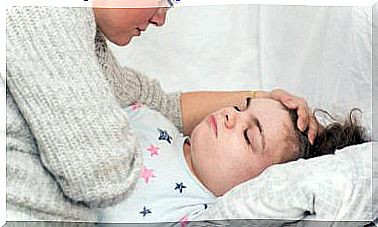Pulmonary Heart: Risks, Causes And Symptoms
Chronic obstructive pulmonary disease is one of the main causes of this condition. But there are others as well. Let’s talk more about the consequences of this pathology.

Cor pulmonale is a condition characterized by damage to the right ventricle of the heart as a result of serious lung disease. Usually there is fluid retention as well as progressive difficulty in breathing.
Treatment options are very limited as it is necessary to address the underlying problem. If you would like to know more about this condition, we invite you to read this article.
What are the symptoms ?
The latter depend on the severity of the disease and result from both the underlying pulmonary pathology and the associated heart damage. It is therefore common to have progressive breathing difficulties (dyspnea).
Initially, they usually appear during moderate physical activity, such as walking long distances or climbing stairs. In the most severe cases, this can even occur while at rest.
Once the heart damage occurs, edema is observed due to the accumulation of fluid in different parts of the body. Swelling of the jugular veins, located in the neck, and enlarged liver (congestive hepatomegaly) are also common symptoms.
Main causes of cor pulmonale
Cor pulmonale is caused by a wide variety of diseases that affect the proper functioning of the lungs. This includes both alteration of the vascular system and of the bronchopulmonary tissue.

Chronic obstructive pulmonary disease
As the name suggests, this pathology involves progressive lung damage resulting from continuous inflammatory reactions. According to the World Health Organization, it is one of the leading causes of death worldwide. The most important risk factors for its development are prolonged smoking and exposure to biomass combustion, for example when cooking with wood.
The main symptoms of COPD are dyspnea, productive cough, and a tendency for respiratory infections. On the other hand, lung damage leads to less oxygenation of the blood. Patients may therefore need permanent oxygen therapy.
There are several associated comorbidities, cor pulmonale being one of them. This worsens the prognosis, as the treatment of these two conditions is difficult.
Cystic fibrosis
It is a disease with a strong genetic component which, although it can affect several systems, usually manifests in the respiratory system. It is characterized by a disorder in the secretions, in particular of the mucus which occurs naturally in the airways.
This then increases the frequency of fatal respiratory infections, such as those produced by Pseudomonas aeruginosa . Most of the time, the lesions are so obvious that cystic fibrosis is diagnosed in the first few months or years of life.
As the disease progresses, it is common for pulmonary hypertension to develop, leading to heart failure. Likewise, it is common for infant mortality to increase significantly after the diagnosis of cor pulmonale. This is what the studies indicate .
Scleroderma
This term is used to describe a collection of disorders that cause fibrosis as well as progressive failure in almost all organs. Fibrosis is a repair process that generates tissue with no specific function.
Dermatological reactions are the most frequent. The lungs are also one of the most affected organs. This then causes diffuse interstitial lung disease and, as in the previous case, pulmonary hypertension.
From an epidemiological point of view, scleroderma generally affects women between the ages of 30 and 50. Although there is no definitive cure, treatment is aimed at relieving symptoms and reducing the associated inflammatory phenomena.
How is cor pulmonale diagnosed?
Doctors use a combination of clinical and paraclinical elements to make the diagnosis. Anatomically, heart damage to the cor pulmonale affects a cavity called the right ventricle and is called hypertrophy and dilation.
The first involves an increase in the thickness of the walls of the cavity. While the second refers to an increase in the size of the ventricle.
They can be suspected by a simple chest x-ray as well as an electrocardiogram. The diagnosis is then confirmed with ultrasonography or nuclear magnetic resonance.
On the other hand, pulmonary hypertension that occurs early is diagnosed through right cardiac catheterization. This technique involves inserting a thin probe through a vein in the inguinal region, neck or arm. The probe is then moved until it reaches the right ventricle of the heart in order to measure its pressure.
Possible treatments

The therapy is complex in most patients, which explains the associated high mortality. Since cor pulmonale is a secondary pathology to another condition, the most effective approach is to eliminate or reduce the changes that cause heart damage. This may not be possible in the most serious cases. Unless you have a lung transplant.
Depending on the patient’s clinical context, certain medications may be administered to relieve symptoms related to fluid retention. Diuretic drugs are useful, although the doctor should take into account certain contraindications against them.
On the other hand, although pulmonary hypertension can be treated with several drugs (such as pulmonary vasodilators), these are generally not effective for conditions that can cause cor pulmonale as a complication.
Prevention of cor pulmonale
To prevent this complication, it suffices to avoid the risk factors for pulmonary pathologies. Here are some effective habits:
- Gradually eliminate tobacco addiction.
- Do not cook with wood.
- Avoid occupational exposure to toxic substances such as silica, asbestos and beryllium.
Cor pulmonale is a serious condition that requires prompt medical evaluation. In case any of the symptoms mentioned above appear, it is strongly recommended to consult a professional as soon as possible. Cardiologists are the most suitable professionals in this case.









